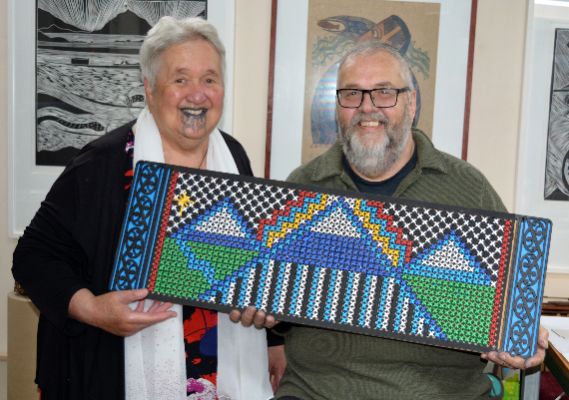Interactive Arapaki Panel Comes To Pukenamu Queens Park

The Whanganui Regional Museum is excited to be hosting the city’s newest interactive art installation.
A large-scale tukutuku panel (locally known as arapaki) has been placed outside the Museum building in Pukenamu Queen’s Park.
Commissioned by Whanganui District Council as part of its town centre regeneration work, the 1.8 x 2.6-metre structure is another addition to the city’s growing collection of outdoor activities provided to the community for public enjoyment.
Tukutuku panels are intricate forms of lattice work depicting various traditional patterns. They are traditionally woven from harakeke (New Zealand flax), pīngao (golden sand sedge) and kiekie (a native vine) into kākaho (toetoe) or raupō (bulrush) stems. Each pattern depicts a significant event, story or characteristic of an Iwi area. The unique Whanganui mumu pattern references the ‘checkers’ board game played by whalers while onshore.
Modern tukutuku panels often include traditional patterns within a contemporary design. The new arapaki panel has a traditional ngutu kākā (kākā beak) design around the border. Members of the public are encouraged to create their own designs using the colourful cross pieces provided with the panel. Museum staff will put the cross pieces out each day during Museum opening hours.
The panel was designed by local artists Marty and Marilyn Vreede of Pakohe Whanganui, a local business producing harakeke (flax) paper and educational resources for teaching te reo Māori.
Marty Vreede says, “In the wharepuni (meeting houses) these panels are both decorative and functional. Decorative, in that they carry patterns and stories and functional, because they provide insulation for the walls.”
Local modelmaker Alex Falkner assisted with the design and build, to develop the panel into a large-scale public artwork.
Town Centre Regeneration Project Manager, Ellen Young, who led the project, says, “The arapaki panel is a beautiful, interactive artwork that enables the community and school groups to interact with Māori art practices, and learn about local traditional craft.”
Whanganui Regional Museum Educator, Margie Beautrais, is looking forward to seeing the community having fun with the panel and being creative. “It’s great to have a hands-on activity outside the building that connects directly with taonga inside the Museum and can be enjoyed by visitors of all ages.”
Karen Hughes, Whanganui Regional Museum


 Hustle Management: Celebrating 50 Years Of Music, Now And Then, With Mark Williams
Hustle Management: Celebrating 50 Years Of Music, Now And Then, With Mark Williams Massey University: Birdnapped Cockatoo Wins Quote Of The Year
Massey University: Birdnapped Cockatoo Wins Quote Of The Year LAWA: “Know Before You Go” – Check Summer Swimming Water Quality Online
LAWA: “Know Before You Go” – Check Summer Swimming Water Quality Online Official Aotearoa Music Charts: 2024 End Of Year Charts Have Been Published
Official Aotearoa Music Charts: 2024 End Of Year Charts Have Been Published Nielsen Book NZ: Nielsen BookData Announces 'In Too Deep' Is The Official New Zealand Number 1 Christmas Bestseller
Nielsen Book NZ: Nielsen BookData Announces 'In Too Deep' Is The Official New Zealand Number 1 Christmas Bestseller PHARMAC: Pharmac Consulting On Six Medicines For New Zealanders
PHARMAC: Pharmac Consulting On Six Medicines For New Zealanders